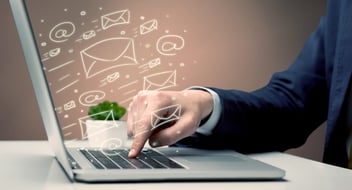The Evolution of Personalization in Marketing: From First Names to Full Experiences
When personalization in marketing first started, it was as simple as “Hi [First Name].” Today, it’s one of the most powerful ways to attract, engage, and convert customers. Personalization has evolved from basic greetings into smart, data-driven strategies—and thanks to modern tools, it’s easier than ever for small and medium-sized businesses (SMBs) to use personalization to get found and grow.
What Is Personalization in Marketing?
Personalization in marketing is the practice of tailoring messages, offers, and experiences to individual customers based on their data, behaviors, and preferences.
In short, personalization helps businesses move away from one-size-fits-all campaigns and instead deliver marketing that feels relevant and valuable to each person. This not only grabs attention but also builds stronger customer relationships.
How Did Personalization in Marketing Begin?
Personalization began with simple tactics like adding a customer’s name to emails or direct mail.
In the early days, personalization meant greeting someone by name or segmenting by basic demographics, like age or location. While innovative at the time, this approach was surface-level and often felt generic—everyone still received the same offers, regardless of their actual needs.
How Has Personalization in Marketing Evolved Over Time?
Personalization has evolved from static name insertion to data-driven, behavior-based strategies powered by CRMs and automation.
As customer relationship management (CRM) systems and marketing automation tools became popular, businesses started segmenting audiences by purchase history, browsing behavior, and engagement. Instead of sending one message to everyone, marketers could tailor content for different customer groups. This was the first big leap toward true personalization.
What Does Personalization in Marketing Look Like Today?
Today’s personalization uses real-time data, AI, and multi-channel strategies to deliver dynamic, relevant customer experiences.
Examples include:
-
Dynamic website content that changes based on who’s visiting.
-
AI-powered recommendations for products, content, or services.
-
Chatbots that provide customized responses.
-
Integrated campaigns where email, ads, SMS, and social media all align to each customer’s journey.
Modern personalization doesn’t just react to what customers do—it anticipates what they need next.
Why Is Personalization Important for Small Businesses?
Personalization helps SMBs compete, build trust, and convert leads into loyal customers—without needing enterprise-level budgets.
Tools like HubSpot, Shopify, and Mailchimp have made personalization affordable and accessible. For SMBs, personalization is especially powerful because it allows you to:
-
Stand out in a crowded market.
-
Increase conversions by showing the right message at the right time.
-
Build stronger, long-term customer relationships.
In today’s world, customers expect personalization, no matter the size of the business.
How Can Small Businesses Start Using Personalization in Marketing?
Small businesses can start by segmenting email lists, using dynamic website content, automating follow-ups, and collecting the right customer data.
Here are a few practical ways to get started:
-
Segment your email list beyond first names—target by purchase history, interests, or lifecycle stage.
-
Use smart CTAs and dynamic content on your website to tailor offers.
-
Automate follow-ups with triggered emails after sign-ups, downloads, or purchases.
-
Collect the right data with forms, surveys, or CRM tracking, but keep it simple and customer-friendly.
What Is the Future of Personalization in Marketing?
The future of personalization is hyper-personalized, AI-driven, and privacy-conscious.
Looking ahead, personalization will continue to evolve in three key ways:
-
Hyper-personalization with AI predicting customer needs in real time.
-
Privacy and trust will play a bigger role, as customers demand control over their data.
-
Personalization as the norm—customers will expect it in every interaction, not just see it as a bonus.
Frequently Asked Questions (FAQ)
What are examples of personalized marketing?
Examples include product recommendations, birthday emails, tailored website content, and follow-up emails after a customer abandons their cart.
Is personalization really effective for small businesses?
Yes! Even small businesses can see higher engagement, conversion rates, and customer loyalty by using simple personalization tactics.
What tools can help SMBs personalize their marketing?
Tools like HubSpot, Mailchimp, Shopify, and ActiveCampaign offer affordable personalization features.
How much data do I need to start personalizing marketing?
Not much. Even basic data like names, purchase history, or past website visits can be enough to start delivering relevant messages.
Personalization in marketing has come a long way—from first-name greetings to AI-powered, multi-channel strategies. For small and medium-sized businesses, personalization is no longer a luxury; it’s an essential way to connect with customers and stay competitive.
If you’re ready to start personalizing your marketing, now is the time. The tools are accessible, the strategies are proven, and the results can transform your business. Get in touch with me today to get your tailored personalization plan.



.png?width=352&name=Research%20Like%20a%20Pro%20Using%20AI%20to%20Understand%20Your%20Audience%20(Even%20With%20a%20Small%20Team).png)